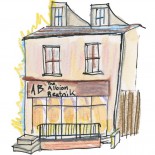The Albion Beatnik Bookstore website (or how to change a light bulb in a tight space on a ladder)
The web page of the Albion Beatnik Bookstore, based once in Oxford, then Sibiu, always neo-bankrupt, now closed for business: atavistic and very analogue, its musings and misspells on books and stuff.
Let’s Talk of Graves, of Worms, & Epitaphs; Make Dust our Paper…

So here’s a nice little copy sold yesterday of George Herbert’s The Temple & A Priest to the Temple, Everyman edition, the binding slightly shaky but from a time when they knew how to publish books that lasted. Joseph Dent was Everyman’s eminence gristle, a man very much under the spell of William Morris and late nineteenth century private press books (Dent had started his career as a bookbinder). He was an intellectual parvenu, the tenth child of a County Durham house-painter who’d left school at 13 but who had ants in his pants and travelled to London like Dick Whittington. He was quite the bibliophilic, clever clogs evangelist, nouveau nous and nimble, his mission to publish a basic and affordable library (“Infinite riches in a little room” was his borrowed mission statement): 50 books at first, in 1906, each priced at one shilling. He had a deft sense of curatorship, each volume a new edition rather than just a bog standard reprint.

Bookworm is all but gone today because of modern paper awash with all sorts of detergent and central heating (and the buggers can’t abide that, but even so it was only within the last ten years that death watch beetle was conquered in the Bodleian Library roof space). In this edition of Herbert though you can see the trace of an initial worm attack on the book’s front endpaper, probably a century old (note the bookseller’s stamp), then its title page. I’m not surprised one bit as the bookworm was noted biologically for its aesthetic sense. And Dent’s tomes had style, I mean why feast off a Tauchnitz (early 1900s airport lounge styled Eurotrash publishing) when a Dent is to hand, and the floral decorations you see on this book were designed by Reginald L. Knowles, his cap doffed to the Arts & Crafts Movement; Beardsley and the marvellous Walter Crane worked also as designers for Everyman.
I am a specialist in ecclesiastical photography. I see it as a form of evidence based ethics. My snapshot storyboard (see below) reveals that the bookworms on page 1 are full still to the brim with bluster and determination, sinful in other words, motivated by impious free will (the confidence of youth, or they may have been low church Baptists on the skid):
“Continence hath his joy ; and so
If rottennesse have more, let Heaven go.”
But by page 29, a Communion or so in to the poetry, there is the suggestion that temporal death is reality, even on the horizon:
“The world and I will quarrell ; and the yeare
Shall not perceive, that I am here.”
A touch of bitterness blights the worms sacerdotal passage on page 39:
“My soul will turn to bubbles straight”
And four pages later the worms are conscious openly of fate and of their need for penitence:
“I do confesse
My foolishnesse ;
My God, accept of my confession.”
My confession is that I am venal and, if money is involved, will never speak in tongues. Therefore, alas, the mechanics of the book sale have cut short my photographic sermon concerning the worm congregation’s acceptance of eternity, and I have failed to chart their various pious states of mind as they either sunk from grace or clung to the lifeboat of salvation (you will see that by page 43 a solitary worm has survived the Divine cull). Suffice it to say that I am not sure that all worms fell prayerfully by the wayside – God only knows why, for Herbert is a concrete and holy hoot, and he could lead me down the Road to Damascus at the drop of a prayer book (not sure about Vaughan, or Billy Graham). But clearly Divine forces of retribution beyond the worms’ control are at play – and we all know that God can be heavy handed. We bear witness to this as the last worm chomps its way to page 139, and here you can just see its final, indeed fatal, mark dabbed on the page. The final worm shaves the ‘f’ on line 5 of EPHES.4.30:
“…the God of strength and power
Griev’d for a worm, which when I tread,
I passe away and leave it dead ?”






